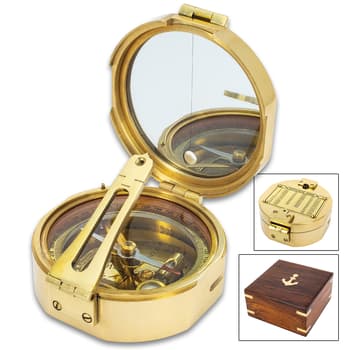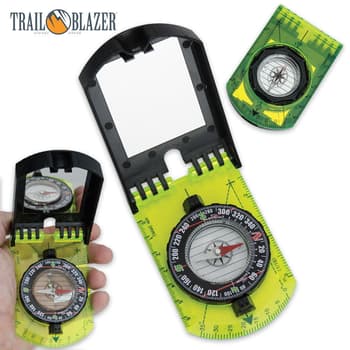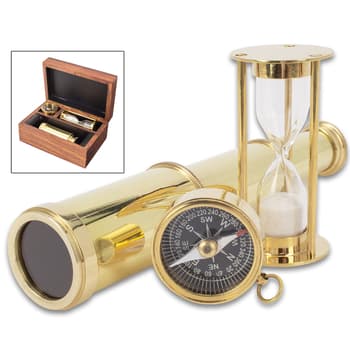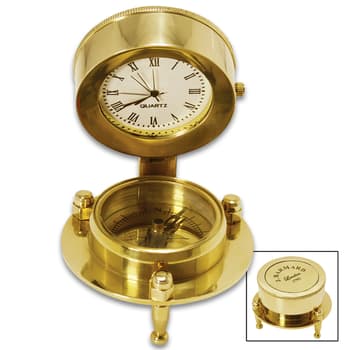Do You Know How To Read A Compass?

By Adelia Ladson
Accurately reading a compass can be deceptively simple. It seems like all that you need to do is look at it and follow the direction that it points to where you want to go. That’s not necessarily true. There’s a science to reading a compass correctly.
Human Error
First and foremost, the compass is never wrong, if used correctly. It’s user error in reading it and taking bearings from it that cause the trouble. The problem from the very beginning is that most folks don’t know which direction they started out from when they started walking. It’s as simple as that but a very costly mistake. The compass will tell you where each of the four directions are located but that means nothing if you don’t know the direction that you need to take to get back to where you started.
How A Compass Works
Now, bear with me if you already know this but a compass doesn’t point to what is termed as “True North”. It points to what is called “Magnetic North” and the term “declination” is the difference between the two. The needle of the compass is always going to point Magnetic North, regardless of what letter it’s pointing to at the moment, since it aligns with the Earth’s magnetic field.
Using A Compass
When you look at the average compass of today, aside from the directions North, South, East, West and all the in-betweens, you will see 360 degrees marked off, as well. These degrees are what you use to take your bearing from when you are using a map and a compass together. By the way, I’m talking about just using a simple, no frills, no thrills compass. There are ones out there that do so much more but let’s stick to the time-tested original. Notes on reading a compass: Make sure the compass is on a level surface when you take your reading because the needle needs to move freely. If the compass is tilted, the needle may catch against the case and not give you a correct reading. Also, make sure that there are no other magnetic fields that will affect your compass when you’re taking a bearing. Items like a cell phone in your pocket or the batteries in your flashlight in your backpack have the possibility of affecting it. Basically, anything that can conduct electricity or produce electricity can interfere.
Using A Compass Without A Map
When simply following a compass in one direction, without using a map, it’s essential that you follow it without deviation. Remember, the direction that the needle is pointing at is not necessarily the direction that you’re facing. This is actually a very common mistake. So, the first thing is to do just what was stated above: turn the compass until the needle is pointing at the “N”. Considering the terrain you may be traveling over, following a direct line could be incredibly difficult. You need to pay attention to the surroundings from where you start all the way to your destination. Keep your eyes open and enjoy the scenery but make sure to make a mental note of landmarks and prominent features along the way. If you have managed to stick to a straight path, to get back to where you started, just turn your compass around and read it. Now, you will read the South needle as your North. This gives you the reversal of direction that you need to retrace your steps back to where you started from.
Using A Compass With A Map
The first thing that you need to know when using a map with your compass is that, based on where you are in the world, there will be a difference between your map’s North and your compass’ North. Most maps will show this declination (the difference between the two) for the specific area so that you can make the adjustment when taking a bearing. To take a bearing using your map, you need to first align the map with your compass. Lay the map on level ground so that North on the map and North on the compass are pointing in the same direction. Remember, though, since your compass is not pointing True North, neither is your map when you align them. This is where declination comes in and you need to look on your map for the degrees of variation you need to account for when making your bearing calculations. It should be on the side of the map somewhere, possibly, in a box.
Agonic Line Note
If you’re in the Appalachian Mountains there’s no variation at all because True North and Magnetic North are in alignment. It sits on an agonic line, which runs through Lake Michigan all the way down to off the coast of Florida.
Using A Compass With A Map Continued
If you’re East of the aforementioned agonic line, the variation will be to the West and if you’re West of it, the variation will be to the East. If your map says the declination is 35 degrees West, then you need to rotate your map that many degrees clockwise so that your compass needle is showing a heading of 35 degrees to the west of the North grid lines on the map. If it says 35 degrees East, just rotate it counterclockwise. Now, that your map and compass are on the same page, so to speak, you can take your bearing. Now, look around you and pick something like a mountain peak or some prominent landmark and find it on your map. Look at the degrees marks on your compass and see what degrees the landmark is located at on it. For example, if you’re using a mountain peak as your landmark, and it is at 145 degrees, you can draw a long line on the map from the representation of the peak at a 145-degree angle. You now have your line of position (LOP). You are located somewhere along this line. To find out where you are on the line, find another landmark that also can be found on your map. Repeat the process of getting its degrees on the compass and draw another line on the map from it at the angle of its degrees. Make sure that you draw the line long enough to intercept your first line. This intersection is where you’re located.
Recommendations
When you’re looking for a compass, you’ll find a ton of styles, giving you plenty of options to choose from. However, in the grand scheme of things, they are basically all the same. You just need to find one that’s easy for you to read and is well-made. Here are my picks from Trailblazer.
Trailblazer Pocket Compass
I’m going to start this list with a simple, basic model that is a nice compact size that can be attached to a keyring. The Trailblazer Pocket Compass has a stainless steel case with a lid to cover the compass face and it has a ring on top so that it can be attached to gear or paracord. The face has a non-glare, black background that’s easy to read and the luminous degree markings stand out. It features precision positive stop for accuracy and a jeweled needle pinon. Just a great, simple little compass to keep with you every day.
Trailblazer Map Compass
Trailblazer’s Map Compass really is an exceptional tool for hiking and orienteering. It’s lightweight with its clear, plastic base that has marking holes for control points and measurements along the edges in both inches and millimeters. The compass has an integrated magnifier in a liquid-filled, clear base with multiple sighting lines on a rotating house. The Map Compass also comes with a neck lanyard so that you can just throw it around your neck and go.
Trailblazer Lensatic Marching Compass
A lensatic compass like the Trailblazer Lensatic Marching Compass is typically used by the U.S. Military and has a little more to it then the basic compass. It’s called a “lensatic” compass because there’s a magnifying reading lens attached to it that flips-up so you can look through it. It has a tough, TPU housing with a flip-up cover, that has a sighting wire, and a long, straight side makes it easy to use with a map. Inside the housing is a liquid dampened compass dial with two-degree graduations and luminous points for low-light readings. The lens allows you to take bearings accurate to within five degrees. The military-style compass also has a hinged thumb-loop to help stabilize the compass for accurate readings.
Trailblazer Military Style Compass
Trailblazer offers another Military Style Compass that I like. It has a sight lens, a sight with crosshairs and a bubble level so that you can make sure it’s level when taking bearings. The face is marked in five-degree increments and the case has a ruler on the side. The compass also has a standard tripod mount, a lanyard and it comes with a nylon belt pouch, which makes it doubly easy to carry.
Trailblazer Heritage Lensatic Compass
Okay, I included the Trailblazer Heritage Lensatic Compass because it’s just a great-looking navigation tool. It is a fully-functional lensatic compass with all the requisite parts. The difference is that it’s entirely made of attractive, polished brass, which gives it a vintage feel. It has the same luminous points and clear bearing markers for low-light readings.
Shop Products Here:



